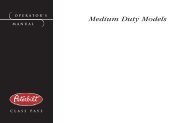Medium Duty Operator's Manual - Peterbilt Motors Company
Medium Duty Operator's Manual - Peterbilt Motors Company
Medium Duty Operator's Manual - Peterbilt Motors Company
You also want an ePaper? Increase the reach of your titles
YUMPU automatically turns print PDFs into web optimized ePapers that Google loves.
Preventive Maintenance<br />
7. If you detect excessive leakage (air pressure loss greater<br />
than 3.0 psi after five minutes of brake application), a<br />
leakage test should be made at the air line connections<br />
and at all air brake control units. These tests should<br />
determine where air is escaping.<br />
Air Compressor<br />
Operation<br />
All compressors, regardless of make or model, run continuously<br />
while the engine is running. System pressure is controlled<br />
by the governor. The governor acts in conjunction with<br />
the unloading mechanism in the compressor cylinder block to<br />
start and stop compression of air. The compressor is<br />
unloaded when the system pressure reaches 120 psi (827<br />
kPa) and compression is re-established when system pressure<br />
falls to 100 psi (690 kPa).<br />
Preventive Maintenance<br />
The following service checks are provided for your information<br />
only and should be performed by a certified mechanic.<br />
Contact your <strong>Peterbilt</strong> Dealer or consult the <strong>Medium</strong> <strong>Duty</strong><br />
Air System<br />
Maintenance <strong>Manual</strong> and the engine manufacturer's Maintenance<br />
<strong>Manual</strong> for further information on servicing air compressors.<br />
After completing any repairs to the air system,<br />
always test for air leaks, and check the brakes for safe operation<br />
before putting the vehicle in service.<br />
According to Table 5, “Air System Scheduled Maintenance,”<br />
Page 192:<br />
• Inspect compressor air filter element, if so equipped, and<br />
replace element if clogged. Check compressor mounting<br />
and drive for alignment and belt tension. Adjust if necessary.<br />
• Remove compressor discharge valve cap nuts and<br />
check for presence of excessive carbon. If excessive carbon<br />
is found, clean or replace the compressor cylinder<br />
head. Also, check compressor discharge line for carbon,<br />
and clean or replace the discharge line if necessary.<br />
• Disassemble compressor and thoroughly clean and<br />
inspect all parts. Repair or replace all worn or damaged<br />
parts, or replace compressor with a factory exchange<br />
unit.<br />
<strong>Medium</strong> <strong>Duty</strong> (R05/09) Y53-6008A – 195 –
















